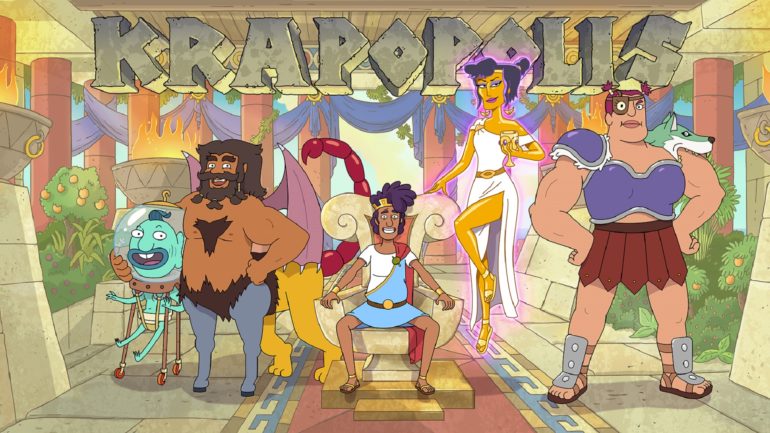English Dub Season Review: Sakamoto Days Season One
Overview (Spoilers Below):
Taro Sakamoto (Matthew Mercer) used to be an unrivaled hitman, earning legendary status in the underworld, but one day, the unthinkable happened: Sakamoto fell in love. He started dating, retired, got married, and had a kid, growing overweight as a result. Though now working as a humble convenience store owner, the world of hitmen still follows him. Sakamoto, along with Shin Asakura (Dallas Liu), a young man with telepathy and employee at his small store, will protect his humble life and family, or die trying.
Our Take:
Sakamoto Days is an anime adaptation of a manga series written and illustrated by Yuto Suzuki. It is directed by Masaki Watanabe, with Taku Kishimoto writing the scripts. It is produced by TMS Entertainment, known for such anime as Soreike! Anpanman, Detective Conan, Dr. Stone, Rent-A-Girlfriend, and Blue Box. Yō Moriyama designed the characters, and Yuki Hayashi composed the music. The opening theme, “Hashire Sakamoto”, is performed by Vaundy, while Conton Candy performed the ending theme, “Futsu” (‘Normal’).
As an assassin, you tend to run into a few problems that’ll test your skills and wits. However, none of them can come close to the most challenging mission of all: retirement. It may sound peaceful, especially when raising a family, but it’s actually a lot more chaotic, especially when you’re urged not to kill anybody. Even in retirement, there’s no escaping the world of criminals and assassins, but that doesn’t make the scenario less fun. Enter Sakamoto Days, the latest anime from Netflix that portrays skilled killers in a light-hearted and humane light, yet retains their usual badass personas whenever necessary.
Consisting of two cours, the series’s plot revolves around former hitman Taro Sakamoto and his attempts to live a tranquil life with his family while running his convenience store. However, his peaceful retirement is constantly interrupted by a slew of assassins attempting to kill him, thanks to a bounty placed on his head by the mysterious assassin killer known as “X”. Fortunately, Taro gains a few extra hands from a few allies to gain an extra hand, including his former protege Shin (Dallis Liu) and a Chinese mob boss’s daughter Lu Xiaotang (Rosalie Chiang). The first cour has Taro confronting these assassins while keeping a low profile due to a no-kill policy created by his wife, Aoi (Rosie Okumura). The second cour then has Taro and his allies battling the infamous serial killers known as Death’s Row sent by Slur, aka “X”. Afterwards, Sakamoto and Shin heads to JCC, a school for assassins, to find information about their ruthless adversary, only for them to encounter the school’s entrance exam, with each stage being deadlier than the last.
As far as my experiences go regarding this concept, I’ve watched some shows that utilized this topic effectively, including Yor Forger in Spy x Family, resulting in these unique anime shows being entertaining and often hilarious. Well, except for The Fable, whose concept is similar to Sakamoto Days but lacks much interest and charm to pack a satisfying punch. This left me wondering if Sakamoto Days would wind up being another successful addition to this category or appear on the hit list for the wrong reasons. Fortunately for me, it’s the former. With its blend of action, comedy, and presentation, Sakamoto Days is another surprise addition to the “assassin’s normal life” concept, offering a mix of fun and hilarity.
Regarding its plot, Sakamoto Days can be easily compared to John Wick. Both concepts involve a renowned assassin coming out of retirement to combat other hitmen targeting them. Given my admiration for the John Wick films, the series felt like a match made in heaven for me, especially since those movies serve as some of its inspirations. However, those inspirations may come with the risk of being a second-rate imitation of those that came before it. Thankfully, that isn’t the case, as Sakamoto Days utilized these inspirations to reinvigorate its “assassin out of retirement” narrative through style, comedy, and occasionally heart. For the latter two, the series features Sakamoto generating empathy amid his dangerous skills when he falls in love with Aoi. However, he seeks to maintain that love by putting his hitman life behind him and not killing people, which happened to be more challenging than anticipated when Slur and the other assassins came around. Much of the stakes in Sakamoto Days usually reside in Sakamoto’s physics-defying battles against the assassins, especially Slur, but the real stake comes from doing so without murdering them. This not only added to the humor of Sakamoto being a kill-less hitman but also the sincerity of his determination to protect and maintain his family life.
On the other hand, the season’s second half, which covers the “JCC Exam” arc, favored a more traditional, action-packed narrative seen in other assassin-focused shows compared to the first half’s unique concept. However, it still retains the humor and character moments depicted in the first half to accompany its stylized presentation and thrilling action scenes. The most notable case is Shin’s growth as Sakamoto’s protege and a part of his new family. The second half puts more focus on Shin’s determination to fight his own battles and protect Sakamoto and his family by mastering his clairvoyant abilities, which, of course, harkens back to other anime involving a character’s journey to become strong. This formula persists in Sakamoto Days, but Taku Kishimoto’s screenplay was able to weave it into the show’s likable characters and entertaining comedy to shoot past its noticeable tropes.
One of the elements from the show that immediately captured my attention was the voice cast. Amid its sea of regular anime voice actors, including Matthew Mercer as Sakamoto, I spotted a few names I immediately recognized from other projects outside of anime. One of them is Rosalie Chiang, who gained recognition from voicing Meilin Lee in “Turning Red” and Chika Amabe in the English dub version of “Suzume”. The other is Xolo Maridueña, renowned for his roles in “Cobra Kai” and “Blue Beetle”, providing the voice of Heisuke Mashimo, a gullible and hyperemotional hitman specializing in sniping. For Chiang, she voices Lu Xiaotang, an air-headed yet competent daughter of a mob boss whose style combines Tai Chi with Drunken Fist. She played a major role in the first half of season one, notably its tenth and eleventh episodes, but the second half shortened her role to focus more on Sakamoto and Shin. Regardless, Chiang did a pretty good job voicing the character, whose drunken techniques delivered plenty of amusing moments. Although some of her line delivery may have sounded wooden at times, she had shown promise in her voice acting career through her performance. While some of the voice acting wasn’t as effective as others, it’s nice to see some variety in the casting choices with names big and small, even in anime from Netflix.
Finally, we have its animation produced by TMS Entertainment. In specific cases, certain shows are often popular due to the presentations that seamlessly integrate into their narratives from most people’s perspectives, such as Demon Slayerand My Hero Academia. While the stories’ executions may leave us with differing opinions, it’s very easy to admit that the animation styles were impressive regarding their translations from the manga panels. Sakamoto Days is certainly no different, especially with its stylization and energetic action sequences. While the visual gags and slapstick also play a role in its presentation, especially the running gag involving Sakamoto imagining killing Shin in his mind, the animation shines the most when it’s focused on the backgrounds, character designs, and dynamic violence. The graphic-like appeal of the artwork, color palettes, and swift action resembled the manga pages coming to life on the screen, a common trait that elevates almost all of the anime adaptations. The animation was vibrantly rich, heavily stylized, and amusingly charming in its visual aesthetics, which is enough to demonstrate that the animation plays a key role in making an action anime thrilling and dynamically immersive.
Overall, Sakamoto Days aligns well with other projects involving assassins coming out of retirement, notably John Wick. However, it effectively utilized the genre’s comical and energetic vibes to battle alongside the media’s former retirees. I felt that the season’s first half was better at taking advantage of its premise because of Sakamoto’s amusing attempts to maintain Aoi’s no-kill policy, especially the “Sugar Park” arc. But, that’s not to say the second half didn’t have moments that were as fun and hilarious as the first cour despite its cliffhanging finale. The English dub cast did a suitable job with their performances, but the show immediately won me over the most through its highly entertaining arcs, likable characters, stylized action scenes, and impressive animation by TMS Entertainment. This is another series that showcases why seeing retired assassins continue to be bad-asses has never felt so exhilarating. If you enjoy watching similar projects like John Wick, then you’ll get a kick out of what this formally retired killing machine has to offer at his convenience store.
























"There are also other characters that come and go (also owned by the Warner Bros. Discovery conglomerate media company)."
Huh. Is that just referring to other characters from the show itself, or is this implying that the new season is going to have cameos from other WBD IPs